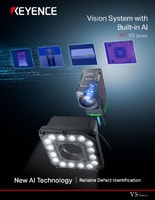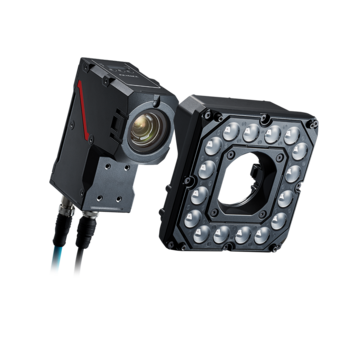Vision Systems
- Vision System with Built-in AI VS series
- Intuitive Vision System CV-X series
- Customizable Vision System XG-X series
- GigE camera and lighting for PC-based machine vision VJ series
- Inline 3D Inspection 3D Vision series
- 3D Vision-Guided Robotics 3D VGR series
- Line Scan Technology Line Scan series
- 2D Vision-Guided Robotics 2D VGR series
- LED Lighting CA-D series
- Lenses (for Machine Vision) CA-L series
- Machine Vision System Database VisionDatabase series
- Automotive
- Automation Equipment/Machine Building
- Electric Vehicles
- Medical Device Manufacturing
- Food/Beverage Packaging
- Semiconductor/Manufacturing Electronics
- Vision-Guided Robotics
- Solar
- Logistics
- Commodities
- Paper Manufacturing
- Machine Tools
- Electronic Device
- Printing
- Mining/Metals
- Fabric/Textile
- Tobacco
- Marine
- Aerospace
Bearing Inspection for the Automotive Industry

With a focus on usability and stability, KEYENCE continues to deliver revolutionary vision systems for automotive manufacturing. Lines of products like the 3D VGR Series and VS Series provide functions required for modern inspection tasks in the automotive industry so the hardworking users in these spaces can continue to bring out automobiles, machines, and systems contributing to modern conveniences.
Our vision solutions also cater to durability, which is as crucial as usability. Explore how vision systems for bearing inspection can help with automotive applications.
We’re here to provide you with more details.
Reach out today!

Challenges in Bearing Inspection for the Automotive Industry
Detecting Missing Balls & Non-Contact Ball Count Inspection
Detecting subtle indicators of missing balls in a wheel bearing and tight spaces, and carrying out ball count inspection without contact disassembly are major challenges in traditional inspection systems.
Blending of Color and Texture
The color and texture of bearings can blend in with other components in the machine design, making scratches, corrosion, and other defects and wear difficult to detect.
Measuring and Dimensional Tolerances
The capability of vision and sensor systems to accurately measure the width and thickness of bearings while still making acceptable allowances for dimensional tolerances can be challenging during wheel-bearing inspection.
Concealed Defects
Accurately checking for obstructions in hidden areas can be problematic. Without using the right inspection systems, small or concealed defects can prevent accurate inspection results.
Discover more about this product.
Click here to book your demo.

Vision Systems for Bearing Inspection for the Automotive Industry
Bearing appearance inspection in automotive manufacturing is crucial to identifying impurities, excessive greasing, and other production anomalies. Aside from these visual checks, bearing inspection reveals issues affecting the structural integrity of the balls, inner and outer raceways, and other components. We provide comprehensive inspection solutions for the appearance, structural integrity, and dimensional accuracy of bearings, ensuring the quality of the inner and outer rings and the balls that facilitate rotation.
Vision System with Built-in AI
AI vision systems support a range of wheel-bearing inspection applications due to their artificial intelligence imaging unit for simple programming. When the rule-based inspection isn’t the best fit, users can also incorporate AI tools for precision-based results.
Line Scan Technology
Line Scan technology captures images one line at a time. This line-based algorithm capturing coupled with line scan cameras helps the Line Scan Series to produce high-resolution images even for small cylindrical targets like ball bearings.
Inline 3D Inspection
With the capability to capture high-resolution images in as little as 0.6 seconds, our inline 3D inspection solution can capture accurate 2D and 3D image data, with the ability to run inspections on both simultaneously.
Intuitive Vision System
We understand that completing wheel bearing inspection for intricate components like bearings in a complex system of machines requires effort. The CV-X Series comes with intuitive vision system controls to ease those efforts.
3D Vision-Guided Robotics
Our 3D vision-guided robotics solutions for robot-assisted wheel bearing inspection tasks, which can be paired with different robots from all major manufacturers.
Curious about our pricing?
Click here to find out more.

FAQs about Bearing Inspection for the Automotive Industry
What Common Defects Can Be Identified Through Bearing Inspection?
Tiny cracks, excessive greasing, breaks, debris obstruction, contaminants, and impurities are common defects identified through wheel bearing visual inspection.
How Does Visual Inspection Improve the Reliability of Automotive Components?
Visual inspection helps to eliminate defects and irregularities that could lead to premature failure of automotive components.
How Do Vision Systems Ensure Reliable Wheel-Bearing Inspection Compared to Conventional Methods?
Wheel bearing inspections done through vision systems provide dependable results compared to conventional methods, as they are more accurate in detecting the smallest defects that go unnoticed by human inspectors.
How Does the Introduction of Vision Systems Enhance the Accuracy of Bearing Inspection?
The introduction of vision systems provides far better accuracy than high-frequency sound wave and magnetic-field technologies used in previous and conventional bearing inspection efforts.
How Do Vision Systems for Bearing Appearance Inspection Handle Environmental Factors Such as Dust, Temperature, and Vibration in Automotive Manufacturing?
Vision systems handle environmental factors like dust through build design that offers IP-rated protective enclosures, climate-controlled inspection cells, and environmental sensors, so wheel-bearing inspection and similar inspections are unaffected.
We’re here to provide you with more details.
Reach out today!

Related Downloads
Related Products
Industries
- Automotive
- Automation Equipment/Machine Building
- Electric Vehicles
- Medical Device Manufacturing
- Food/Beverage Packaging
- Semiconductor/Manufacturing Electronics
- Vision-Guided Robotics
- Solar
- Logistics
- Commodities
- Paper Manufacturing
- Machine Tools
- Electronic Device
- Printing
- Mining/Metals
- Fabric/Textile
- Tobacco
- Marine
- Aerospace





